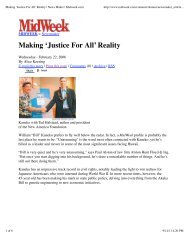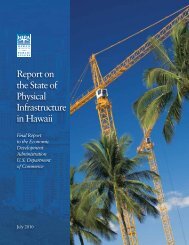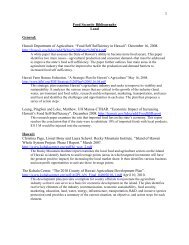Hawai'i Fisheries Initiative - The Hawaii Institute for Public Affairs
Hawai'i Fisheries Initiative - The Hawaii Institute for Public Affairs
Hawai'i Fisheries Initiative - The Hawaii Institute for Public Affairs
Create successful ePaper yourself
Turn your PDF publications into a flip-book with our unique Google optimized e-Paper software.
503 Wendie Ellen Schneider, Contentious Business:<br />
Merchants and the creation of a Westernized<br />
judiciary in Hawai‘i,” 108 Yale L.J. 1389 (1999),<br />
citing In re Estate of His Majesty Kamehameha IV,<br />
2 Haw. 715, 720 (1864).<br />
504 Peter Apo, Dennis “Bumpy” Kanahele, Cherlyn<br />
Logan, Dr. Davianna McGregor, John M. Knox &<br />
Associates, ed., Planning <strong>for</strong> sustainable tourism in<br />
Hawai‘i (2004), prepared <strong>for</strong> Hawai‘i Department<br />
of Business Economic Development & Tourism,<br />
at http://www.<strong>Hawaii</strong>.gov/dbedt/info/visitorstats/<br />
sustainable-tourism-project/drafts/Native-<strong>Hawaii</strong>an-<br />
Impact-Report.pdf, p. 10.<br />
505 Alan Friedlander, Bob Endreson, William Aila,<br />
Linda Paul, with the assistance of DAR, Pacific<br />
<strong>Fisheries</strong> Coalition whitepaper, <strong>The</strong> Status<br />
of Hawai‘i’s Living Marine Resources at the<br />
Millennium, at http://www.pacfish.org/wpapers/<br />
fishstatus.html. See also Ka Hana Lawai‘a a me na<br />
ko‘a o na kai‘ewalu [electronic resource] : a history<br />
of fishing practices and marine fisheries of the<br />
<strong>Hawaii</strong>an Islands. Compiled from Native <strong>Hawaii</strong>an<br />
traditions, historical accounts, government<br />
communications, Kama’aina testimony and<br />
ethnography. Honolulu, HI : Kamehameha Schools<br />
Land Assets Division, 2004. DU624.6 .N35 2004.<br />
506 Organic Act of April 30, 1900, Chapter 339, 31<br />
Stat. at L. 141, 160. “[A]ll laws of the Republic of<br />
Hawai‘i which confer exclusive fishing rights upon<br />
any person or persons are hereby repealed, and<br />
all fisheries in the sea waters of the Territory of<br />
Hawai‘i not included in any fish pond or artificial<br />
inclosure shall be free to all citizens of the United<br />
States, subject, however, to vested rights; but no<br />
such vested rights shall be valid after three years<br />
from the taking effect of this Act unless established<br />
as hereinafter provided.” Hawai‘i Organic Act, ch.<br />
6, § 95 (2001) (original version at ch. 339, 31 Stat.<br />
141 (2 Supp. R. S. 1141). See also, United States v.<br />
Kaiser Aetna, 408 F. Supp. 42, 51 (D. Haw. 1976),<br />
aff’d, 584 F.2d 378 (9th Cir. 1978), rev’d, 444 U.S.<br />
164 (1979), specifically exempting fishponds from<br />
the scope of the Hawai‘i Organic Act of 1900.<br />
507 See Haalelea v. Montgomery, 2 <strong>Hawaii</strong>an R. 62,<br />
66; Kapiolani Estate v. Territory of Hawai‘i, 18<br />
Haw. 460 (1907); state v. <strong>Hawaii</strong>an Dredging<br />
Co., 48 Haw. 152, 397 P.2d593 (1964); Bishop<br />
v. Mahiko, 35 Haw. 608 (1940); Damon v.<br />
Territory of Hawai‘i, 194 U.S. 154 (1904) at<br />
http://caselaw.lp.findlaw.com/cgibin/ getcase.<br />
pl?court=us&vol=194&invol=154.<br />
508 Ian Hlawati, “Loko I‘a: A legal guide to the<br />
restoration of Native <strong>Hawaii</strong>an fishponds within<br />
the Western paradigm,” 24 U. Haw. L. Rev. 657<br />
(2002), citing Melody MacKenzie, Native <strong>Hawaii</strong>an<br />
Rights Handbook (1991), p. 177.<br />
509 Ian Hlawati, “Loko I‘a: A legal guide to the<br />
restoration of Native <strong>Hawaii</strong>an fishponds within<br />
the Western paradigm,” 24 U. Haw. L. Rev.<br />
657 (2002), citing Melody MacKenzie, ed., <strong>The</strong><br />
Native <strong>Hawaii</strong>an Rights Handbook, p. 177; Alan<br />
Murakami, Konohiki Fishing Rights and Marine<br />
Resources, in Native <strong>Hawaii</strong>an Rights Handbook,<br />
at 173-95; and “In Smith v. La‘amea the court<br />
stated: ‘We understand the word tenant, as<br />
used in this connection, to have lost its ancient<br />
restricted meaning, and to be almost synonymous<br />
at the present time with the word occupant, or<br />
occupier, and that every person occupying lawfully<br />
any part of an ahupua‘a ‘is a tenant within the<br />
meaning of the law. Those persons who <strong>for</strong>mally<br />
lived as tenants under the konohikis but who<br />
have acquired fee simple title to their kuleanas,<br />
under the operation of the Land Commission,<br />
continue to enjoy the same rights of piscary that<br />
they had as hoaainas under the old system. . . .<br />
If any person who has acquired a kuleana on the<br />
ahupua‘a of Honouliuli should sell and convey his<br />
land, or even a part of it, to another, a common<br />
right of piscary would pass to the grantee, as an<br />
appurtenance to the land.” Smith v. La’amea, 29<br />
Haw. 750, 755-56 (1927) (quoting Haalelea v.<br />
Montgomery, 2 Haw. 62, 71 (1858).<br />
510 Damon v. Territory of Hawai‘i 194 U.S. 154<br />
(1904), referencing Wedding v. Meyler, 192 U.S.<br />
573 , 583, ante, p. 322, 24 Sup. Ct. Rep. 322, at<br />
http://caselaw.lp.findlaw.com/cgibin/ getcase.<br />
pl?court=us&vol=194&invol=154. See also Haalelea<br />
v. Montgomery, 2 <strong>Hawaii</strong>an R. 62, 66.<br />
511 HRS § 187A-23; Ian Hlawati, “Loko I‘a: A legal<br />
guide to the restoration of Native <strong>Hawaii</strong>an<br />
fishponds within the Western paradigm,” 24 U.<br />
Haw. L. Rev. 657 (2002), part III, “Analysis: Legal<br />
Guide to Restoration.” “In 1982, the Hawai‘i<br />
Supreme Court recognized in Reppun v. Board<br />
of Water Supply (656 P.2d 57, at 68-69 (1982) that<br />
there had been unjustified losses of customary<br />
<strong>Hawaii</strong>an rights, including konohiki fishing rights.<br />
Having recognized their own historical errors, the<br />
court held that with regard to water rights, the<br />
grant of such water rights to a konohiki owner<br />
were inseparable from the konhiki’s duty to<br />
provide <strong>for</strong> his tenants. <strong>The</strong> court implied that<br />
their holding with regard to water rights had<br />
application to the analogous land and fishing<br />
rights. Reppun represented a marked departure<br />
from what had previously been held in <strong>Hawaii</strong>an<br />
Dredging. Under Ash<strong>for</strong>d (440 P.2d 76 (1968),<br />
Reppun, and PASH (79 Hawai‘i at 445-46, 903 P.2d<br />
at 1266-67), <strong>Hawaii</strong>ans with or without vested<br />
property interests in fishponds may have judicially<br />
en<strong>for</strong>ceable rights to fish at these sites.”<br />
512 Hawai‘i Constitution, Article XI, Section 6, at http://<br />
www.<strong>Hawaii</strong>.gov/lrb/con/conart11.html.<br />
513 D. Kapua Sproat, <strong>The</strong> backlash against PASH:<br />
legislative attempts to restrict Native <strong>Hawaii</strong>an<br />
rights, 20 U. Haw. L. Rev. 321 (1998), part III, citing<br />
Haw. Const. .art. XII § 7.<br />
514 John Van Dyke, “<strong>The</strong> role of indigenous peoples in<br />
ocean governance: Traditional native approaches<br />
to ocean governance,” part of the United Nation’s<br />
University’s Integrated Ecosystems, Pacem in<br />
Maribus XIX conference, at http://www.unu.edu/<br />
unupress/unupbooks/uu15oe/uu15oe0a.htm, citing<br />
Opinion letter written by the Department of the<br />
Attorney General, Land Transportation Division,<br />
to the Chair of the Board of Land and Natural<br />
Resources, State of Hawai‘i, 24 June 1982.<br />
515 OHA’s claim to share equally in the harvest may<br />
find support in a 1979 U.S. Supreme Court decision<br />
(443 US 658) upholding the Boldt Decision, the<br />
result of a 1970 federal suit against the state of<br />
Washington that allocated 50 percent of state’s<br />
catch to land-holding native American Indians<br />
under an interpretation of treaties between the<br />
U.S. and the Indian tribes. See Sharon Boswell and<br />
Lorraine McConaghy, “A Resource Divided, Seattle<br />
Times, Nove. 10, 1996, at http://seattletimes.<br />
nwsource.com/centennial/november/resource.<br />
html; also see “Federal Judge George Boldt issues<br />
historic ruling affirming Native American treaty<br />
fishing rights on February 12, 1974,” at http://<br />
www.historylink.org/essays/output.cfm?file_<br />
id=5282.<br />
516 John Van Dyke, “<strong>The</strong> role of indigenous peoples in<br />
ocean governance: <strong>The</strong> pursuit of ocean claims,”<br />
United Nation’s University’s Integrated Ecosystems,<br />
Pacem in Maribus XIX conference, at http://<br />
www.unu.edu/unupress/unupbooks/uu15oe/<br />
uu15oe0a.htm: “On 2 September 1989, the Office<br />
of <strong>Hawaii</strong>an <strong>Affairs</strong> issued a Draft Blueprint <strong>for</strong><br />
Native <strong>Hawaii</strong>an Entitlements which included<br />
the following paragraph among the claimed<br />
entitlements: Submerged Lands and Offshore<br />
123







